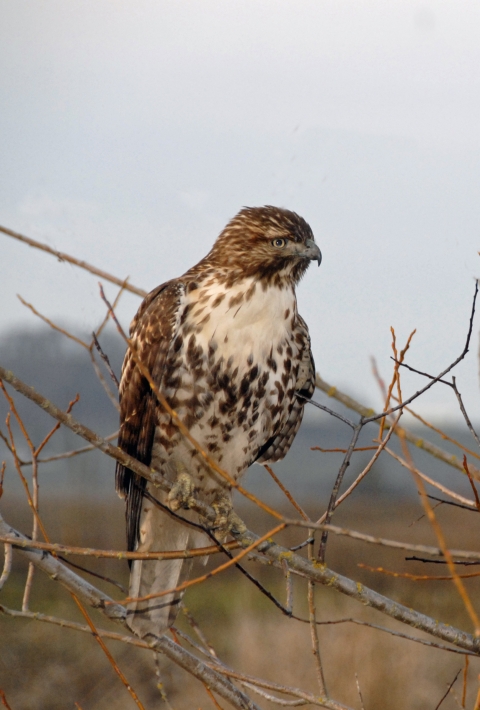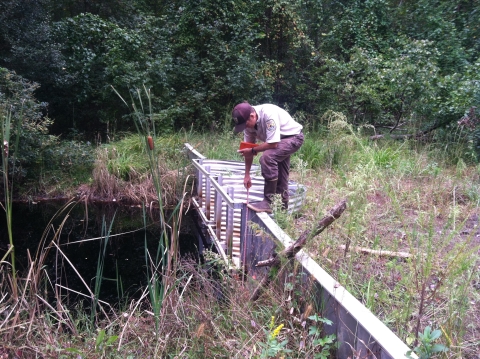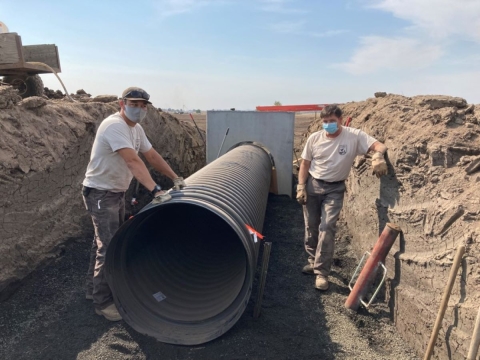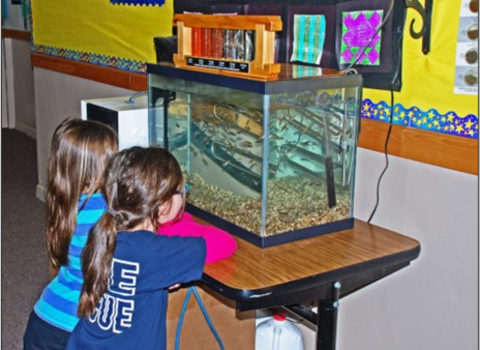This year is the 50th anniversary of the Endangered Species Act, a law that has been a powerful catalyst for conservation of America’s most treasured fish, wildlife, plants and their habitats. In the Pacific Region, our Tribes, state and federal agencies, and partners have joined with our dedicated staff to be the driving force behind the successes we share and the strength ensuring we can address the challenges ahead. Celebrate this milestone with us in this collection of stories as we reflect on past successes, assess current challenges, and envision an equally bright future for the next 50 years and beyond.
----
Robert Little has always been passionate about the outdoors. Raised on a farm in Southern Washington, he learned the importance of protecting natural resources and to appreciate their intrinsic value from a young age. It was only natural for Robert to join the U.S. Fish and Wildlife Service in 1984 as a heavy equipment operator where he would spend the next 36 years working to manage habitats and protect wildlife at our National Fish Hatcheries and National Wildlife Refuges.
Robert’s love for the outdoors led him to the Baskett Slough National Wildlife Refuge. Established in 1965, the 2,500-acre refuge is an oasis for waterfowl in Oregon’s Willamette Valley. Refuge staff work diligently to cultivate habitat for the many species of birds that travel along the Pacific flyway and stop at the refuge to feed and rest. Previously used for agriculture, the refuge lands had been drained to grow crops and the natural wetlands were lost over time. To convert wetlands to dry fields, past landowners had straightened and channelized the Baskett Slough Creek, which travels south and then east through the refuge. These channels helped syphon water from the landscape to create land for agricultural production.
In 1997, he joined a team of maintenance workers and heavy equipment operators who were working there to restore the Dusky Marsh at Baskett Slough National Wildlife Refuge. The Dusky Marsh restoration project was a major undertaking to fulfil the refuge’s mission and maintain waterfowl habitat. The project’s goal was to restore the drained marsh and provide seasonal wetland habitat for migrating birds such as dusky Canada geese. Creating more habitat would give these birds room to feed and encourage them to stay on protected refuge lands rather than on neighboring farms where they can cause crop damage.
To build a wetland, the refuge needed to be able to collect water. This is where Robert and his team came in. They installed two water control structures within the channelized waterway and built a 3,000-foot-long earthen dam to hold water. As rainfall runoff traveled down the stream, the structures would allow the refuge staff to dam certain areas and create the desired wetland habitat. The project was a success and soon the restored Dusky Marsh was attracting wintering waterfowl and supporting thousands of Canada geese, cackling geese, and dabbling ducks.
Robert left Baskett Slough National Wildlife Refuge in 2001 and continued working at refuges and hatcheries across the Western United States. However, a few years after Robert left, the refuge and staff learned something very interesting about the Dusky Marsh project. At the time it was constructed, the common practice for wetland restoration was to use water control structures to dam streams and collect water. Over time, however, biologists started to think more holistically about habitat restoration projects and began to consider fish passage fish passage
Fish passage is the ability of fish or other aquatic species to move freely throughout their life to find food, reproduce, and complete their natural migration cycles. Millions of barriers to fish passage across the country are fragmenting habitat and leading to species declines. The U.S. Fish and Wildlife Service's National Fish Passage Program is working to reconnect watersheds to benefit both wildlife and people.
Learn more about fish passage barriers in flood plains and their effects on an ecosystem. Native fish require unobstructed waterways to travel upstream and spawn each year, and a lack of navigable streams is a major reason for fish declines in the Pacific Northwest. After surveying Baskett Slough Creek, biologists found that same water control structures that helped to create the Dusky Marsh did not allow for fish to easily travel up or downstream. This new information prompted a rethinking of how to manage the wetland while also improving fish passage.
In 2017, the refuge began working with the Oregon Department of Fish and Wildlife to fix the problem. The easiest and cheapest solution would have been to add fish ladders to the water control structures. These ladders allow fish traveling upstream to “climb” above barriers and continue on their way. While these ladders are effective, they do not solve the problem of unobstructed fish movement and the structures still prevent some fish from reaching their desired locations.
The refuge decided to go the extra mile and remove the structures entirely with the goal of returning the creek to its original condition. The unnaturally high straight sides of Dusky Marsh’s agricultural channels not only prevented seasonal wetland flooding but also made poor wildlife habitat for aquatic species. Fish need undulating banks and structures such as fallen trees to hide from predators and forage for food. The plan was to re-establish a curving stream and add natural debris to protect migrating wildlife.
Something temporarily or permanently constructed, built, or placed; and constructed of natural or manufactured parts including, but not limited to, a building, shed, cabin, porch, bridge, walkway, stair steps, sign, landing, platform, dock, rack, fence, telecommunication device, antennae, fish cleaning table, satellite dish/mount, or well head.
Learn more about structure commonly used to create wetlands and regulate water flow
Removing the water control structures would, however, limit the refuge’s ability to collect water and maintain the restored wetlands. To solve this problem, the team decided to create a new setback earthen dam that would run parallel to the creek, behind which water could pool for wildlife habitat. The stream in its newly designed stream channel would also provide seasonal wetlands as water would be able to flood its low banks during heavy rain events before eventually travelling downstream and emptying into the Willamette River.
A major obstacle remained for the refuge to begin construction, however… funding. In the Willamette Valley of Oregon, heavy winter and spring rainfall means that largescale projects like this one must be completed during the short, sunny summer months. Construction would take eight weeks and would require over a dozen skilled maintenance specialists and heavy equipment operators to move over 30,000 cubic yards of earth and remove two water control structures. To obtain the necessary permits, the refuge would need to collaborate with environmental engineers and map out how to make this restoration a reality without compromising waterfowl habitat or jeopardizing neighboring farmers’ lands. These investments can be costly.
Thanks to the passage of the Great American Outdoors Act in 2020, the U.S. Fish and Wildlife Service now had access to funding to invest in habitat improvement projects which would also expand recreational access for the American public. With the newly available funds, the Service hired Maintenance Action Teams (MAT) to travel to refuges and tackle challenging habitat restoration and deferred maintenance projects like the Dusky Marsh restoration.
MAT team volunteers come from all over the country and bring a diverse set of skills with them. These projects are not only essential for habitat restoration, but they allow seasoned workers to mentor newer employees, helping them to learn new skills and obtain necessary certifications on different types of machinery so they can continue to restore habitats for years to come. When Robert Little heard about the Dusky Marsh restoration plans, he eagerly agreed to join the MAT team and headed back to one of his first projects to participate in the upgrade.
In August of 2021, the first MAT team broke ground with Robert and engineering equipment operator Jeremy DePiero leading the charge. After 36 years with the agency, the Dusky Marsh renovation project would be one of Robert’s last before retirement. “One thing I love about the U.S. Fish and Wildlife Service,” said Robert, “is that when we have new scientific information or when we learn a better way of doing something, we work to upgrade our best management practices. When we installed the water control structures in 1997, that was the best way to create a wetland on the refuge. With new information, we are now upgrading the design to allow for better fish passage and to improve habitat for native fish while still helping waterfowl.”
Throughout August and September, the MAT teams worked long hours and endured record heat to ensure the project was completed before the fall rains began. To meet their schedule, teams of seven labored over seventy hours a week to get all the work done. By late September 2021, they had restored nearly a mile of Basket Slough Creek, removed an old dam on the eastern boundary of the property that blocked waterflow, and created a new setback dam parallel to the creek to ensure the wetlands persisted. The 98-acre restoration project not only improves fish passage and provides habitat for waterfowl, but it also supports federally listed species such as Nelson’s checkermallow, the Willamette daisy, and the streaked horned lark that will use the restored wet prairie habitat within the project’s footprint.
Projects like this need talented and hard-working MAT team staff like Robert and Jeremy who battle the elements, overcome equipment challenges, and move mountains to get the job done. “Coming back here to work on this project at the end of my career feels like I’ve come full circle,” said Robert. “This is the best way to celebrate my retirement, and I will head into the next chapter knowing that I helped make this habitat better for the plants and animals that I love.” Robert, Jeremy, and the sixteen members of the MAT team were instrumental in this project’s success. Without their skills and expertise, restoration stories like this would not be possible.









